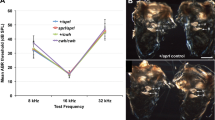Summary
-
1.
The genesVa, sh-2 anclje have fundamentally the same effect on behaviour, growth rate and the labyrinth in the mouse.
-
2.
They all produce deafness, shaking movements of the head and a tendency to run in circles in the affected animal.
-
3.
They have no significant effect on birth weight, but retard growth somewhat in the first 4 weeks of life.
-
4.
In the cochlea of affected mice the first organ to show abnormality is the tectorial membrane. It does not thin out to normal dimensions till about the end of the 2nd week.
-
5.
It is followed by degeneration of the spiral ganglion and the hair cells and dedifferentiation of the organ of Corti during the 2nd week. This degeneration is progressive.
-
6.
The stria vascularis degenerates in the 3rd week.
-
7.
The development of the anomaly in the pars superior is not quite the same in all the three mutants. InVa/+ mice the cristae ampullares are severely affected and the maculae only slightly; inVa/Va mice all the five sense organs are severely affected; in shakers-2 and jerkers the maculae are affected even at the time of birth, while the cristae are apparently normal throughout. The anomaly, however, always consists in a progressive degeneration of the neuro-epithelial cells.
-
8.
The average cell size in the vestibular ganglion is considerably reduced inVa/+ andVa/Va mice and only slightly in shakers-2, while in jerkers it is unaffected.
-
9.
As in waltzer and skaker-1 the degeneration sets in in an organ which is fully differentiated. However, various minor anomalies, present before the degenerative changes set in, suggest that the labyrinthine sense organs may not be quite sound from the very beginning. The group differs fundamentally from the mutants shaker-short, kreisler, dreher and fidget, in which gross defects of morphogenesis become apparent early in development.
-
10.
The deafness of these mice is fully explained by the cochlear degeneration; but nothing so certain can be said of their behaviour. The shaking of the head may be due to loss of tone in the neck muscles resulting from the defects of the utricular macula and the ampullary cristae or it may be central in origin.
-
11.
The interpretation suggested by Griineberget al. (1940) in the case of shaker-1 cannot be valid for the mutants dealt with here for a variety of reasons. It is suggested that these mutants represent cases of ‘abiotrophy’, i.e. a breakdown of tissue due to unidentified biochemical causes.
Similar content being viewed by others
References
Abercrombie, M. (1946). Estimation of nuclear population from microtome sections.Anat. Sec. 94, 239–47.
Bonnevie, K. (1936a). Vererbbare Gehirnanomalie bei Kurzschwänzigen Tanzmäusen.Acta path. micrdbiol. scan. (Suppl.),26, 20–6.
Bonnevie, K. (1936b). Abortive differentiation of the ear vesicles following a hereditary brain-anomaly in the short-tailed waltzing mouse.Genetica,18, 105–25.
Bonnevie, K. (1940). Tatsachen der genetischen Entwicklungsphysiologie.Handbuch der Erbbiologie des Menschen,1, 73–180. (Quoted fromAnimal Genetics and Medicine, by H. Grüneberg, Hamish Hamilton Medical Books, London, 1947.)
Cloudman, A. M. &Bunker, L. E. (1945). The Varitint-waddler mouse. A dominant mutation inMus musculus. J. Hered.16, 259–63.
Deol, M. S. (1953). The developmental Genetics of some mutants affecting the labyrinth in the mouse. Ph.D. thesis, University of London.
Dobrovolskaia-Zavadskaia, N. (1928). Ľirradiation des testicules et ľhérédité chez la souris.Arch. Biol., Paris,38, 457–501.
Dunn, L. C. (1934). A new gene affecting behaviour and skeleton in the house mouse.Proc. Nat. Acad. Sci., Wash.,20, 230–2.
Falconer, D. S. &Sierts-Roth, U. (1951). Dreher, ein neues Gen der Tanzmausgruppe bei der Hausmaus.Z. indulct. Abstamm.- u. VererbLehre,84, 71–3.
Grüneberg, H. (1943). Two mutant genes in the house mouse.J. Genet. 45, 22–8.
Grüneberg, H. (1952).The Genetics of the Mouse, pp. 650. The Hague: Martinus Nijhoff.
Grüneberg, H., Burnett, J. B. &Snell, G. D. (1941). The origin of jerker, a new mutation in the house mouse and linkage studies mad with it.Proc. Nat. Acad. Sci., Wash.,27, 562–5.
Grüneberg, H., Hallpik, C. S. &Ledoux., A (1940). Observations on the structure, development and electrical reactions of the internal ear of the shaker-1 mouse (Mus Musculus).Proc. Roy. Soc. B,129, 154–73.
Guild, S. R. (1927). The circulation of the endolymph.Amer. J. Anat. 39, 57–81.
Hertwig, P. (1942). Neue Mutationen und Koppehmgsgruppen bei der Hausmaus.Z. indulct. Abstamm.- u. VererbLehre,80, 220–46.
HertwiG, P. (1944). Die Genese der Hirn-und Gehörorganmissbildungen bei röntgenmutierten Kreisler-Mäusen.Z. ges. Anat. 2.Z. KonatLehre,28, 327–54.
Hertwig, P. (1951). Entwicldungsgeschichtliche Untersuchungen über Bewegungsstörungen bei Mäusen.Verh. anat. Ges. Jena,49, 97–107.
vander Hoeve, J. (1923). Relation between the eye and ear (including the vestibular organ)Ann. Otol. etc., St Louis,32, 571–87.
Kuiper, T. (1913). Die functionellen und hirnanatomisphen Befunde bei der japanischen Tanzmaus. Med. Dissertation, Amsterdam, pp. 154.
van Lennep, E. C. C. (1910). Het verloop der afwijkingen in hot gehoororgaan van der japansche dansmuis. Med. Dissertation, Utrecht, pp. 82.
Lord, E. M. &Gates, W. H. (1929). Shaker, a new mutation in the house mouse (Mus musculus)Amur. Nat. 63, 435–42.
Löwenstein, O. (1936). The equilibrium function of the vertebrate labyrinth.Biol. Rev. 11, 113–45.
Meng, T. H. (1933). The internal ear of the shakerMus musculus.Pelcing Nat. Hist. Bull. 7, 355–60
Richardson, K. O. (1952). Mounting collodion sections before staining.Quart. J. Micr. Sci. 93,371–4.
Shambaugh, G. E. (1908). On the structure and function of the epithelium in the sulcus spiralis externus.Arch. Otol., N.Y.,37, no. 6.
Tansley, K. (1951). Hereditary degeneration of the mouse retina.Brit. J. Ophthal. 35, 573–82.
Treacher-Collins, E. (1919). Diseases of the Retina. Part 1. Abiotrophy of the retinal neuro-epithelium or Retinitis Pigmentosa.Trans. Ophthal. Soc. U.K. 39, 165–95.
Woolley, G. W. &Dickie, M. M. (1945). Pirouetting mice.J. Hered.,36, 281–284.
Zimmermann, K. (1935). Erbliche Gehirnerkrankungen der Hausmaus.Erbarzt (Beil. z. Dtsch. Aerztebl.) 1935,2, pp. 119–20.
Author information
Authors and Affiliations
Rights and permissions
About this article
Cite this article
Deol, M.S. The anomalies oe the labyrinth of the mutants varitint-waddler, shaker-2 and jerker in the mouse. J Genet 52, 562–588 (1954). https://doi.org/10.1007/BF02985081
Received:
Issue Date:
DOI: https://doi.org/10.1007/BF02985081




